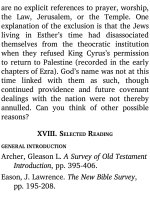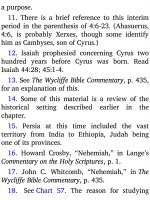Jensens survey of the old testament adam 515
Bạn đang xem bản rút gọn của tài liệu. Xem và tải ngay bản đầy đủ của tài liệu tại đây (117.74 KB, 4 trang )
return. Here, the apostle not only gives the
details of prophecy but he also shows how
Christians should be living day by day in
light of the Lord’s return. That practical
emphasis will be evident as you study the
epistles.
I. PREPARATION FOR STUDY
Before you begin to read the Thessalonian
letters, answer the following questions on
the basis of your present knowledge and
interpretation of eschatology (doctrine of
last things):
1. Will Jesus return to this earth? If so,
what signs or events will precede His
coming?
2. Will the saints be raptured (caught up)
to heaven before Christ returns to the earth?
If so, will there be a period between such a
rapture and His coming to earth?
3. What will Christ do when He returns?
4. For how long will Christ remain on
earth? Then what?
II. BACKGROUND OF THE THESSALONIAN LETTERS
A. THE CITY OF THESSALONICA
1 . Name. The city was originally named
Therme. When it was refounded by
Cassander, around 315 B.C., he named it
Thessalonica, after his wife.
2. Location. Study carefully the location of
Thessalonica, as shown on Map V, page 337.
Note the city’s strategic position as a seaport
and on the Egnatian Way, which was the
principal east-west trade and military route
between Rome and Asia Minor.2 How does
this strategic location shed light on 1
Thessalonians 1:8?
Observe the other two important cities of
this part of Macedonia, Philippi, and Berea,
which Paul visited on his second missionary
journey. Why did Paul concentrate much of
his missionary tours in key cities of the
Empire?
Note the location of Corinth on the map.
It was from here that Paul wrote both of the
Thessalonian letters.
3 . Population.
The
population
of
Thessalonica in Paul’s day has been
estimated as around 200,000 (about half its
present population). Of this number most
were Greeks, but there was also a fairly
large Jewish segment in the city. From the
following description, try to visualize Paul’s
impressions of the bustling city as he rst
entered it on his second missionary journey
(Acts 17:1):
With overland caravans thronging
its hostelries, with its harbor lled
with ship’s bottoms from overseas,
with old salts, Roman o cials, and
thousands of Jewish merchants
rubbing shoulders in its streets,
Thessalonica
presented
a
cosmopolitan picture. It is very
suggestive
that
the
Jewish
opponents of Paul should have
called Paul and his co-workers
“world-topplers” (Acts 17:6).3
4. Government. Thessalonica was made the
capital of the province of Macedonia in 148
B.C. It gained the status of a free city in 42
B.C. and elected its own government o cials.
(Note the reference to city rulers in Acts
17:6.)
5 . Commerce. As noted earlier, the city
was a strategic trade center, with
connections by land and sea. This
determined its commercial “personality.” It









